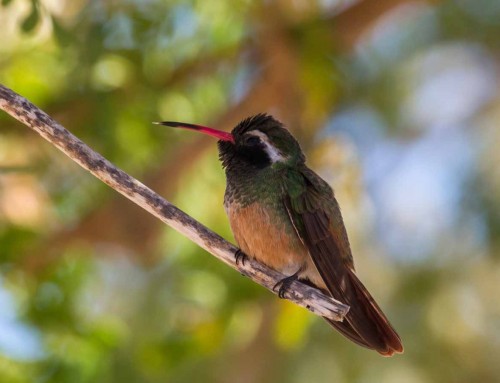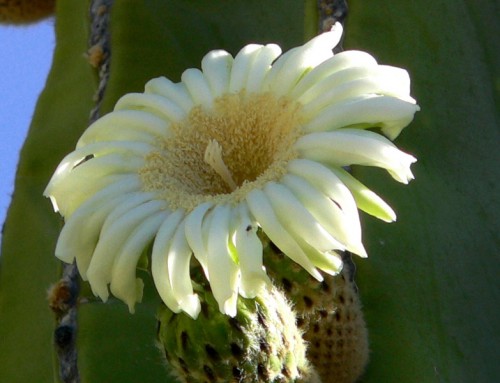Spotlight Series contains blog posts written by Searcher naturalists on curious and fascinating topics from our Searcher Natural History Tours to Baja California. Search for “Spotlight Series” to read them all.
by Searcher naturalist, Paul Jones
Recent research in the field of seabird ecology has revealed something that would have been nearly unthinkable 30 years ago, namely that ocean-going birds such as shearwaters, petrels, and albatrosses are getting around by scent. I saw my first black-footed albatross in 1979 during an ornithology class field trip to the Farallon Islands, which are 25 miles off of San Francisco. Here’s that magnificent bird, which I happened to catch with my Nikon camera and 300-mm lens (state-of-the-art back in the day).

Black-footed albatross “dynamic soaring” in the breeze near Southeast Farallon Island, 1979.
If someone had told us then that researchers would be putting geo-loggers on birds and using computers to track their wanderings across the ocean in the early part of the next century, we would probably have laughed. But, sure enough, it’s all come to pass and it’s shedding a whole new light on seabirds’ dependence on olfaction.
In a wonderful book, The Seabird’s Cry: The Lives and Loves of the Planet’s Great Ocean Voyagers by Adam Nicholson, the award-winning author takes you through the lives of a dozen seabirds, with revelations about early and recent findings in seabird research.

Black Storm-Petrel @ Tom Blackman
As highlighted by Nicholson, studies show that birds are using their sense of smell at multiple scales and for different reasons. At the ocean basin level, it’s used to find food. Closer to home, they find burrows or nests and it can also help in mate or chick recognition. As stated in an abstract by Milo Abolaffio and his co-authors in a recent paper on shearwater movements:
“After foraging in the open ocean pelagic birds can pinpoint their breeding colonies, located on remote islands in visually featureless seascapes. This remarkable ability to navigate over vast distances has been attributed to the birds being able to learn an olfactory map on the basis of wind-borne odors.”
There’s even anatomical evidence of the importance of olfaction in ocean-going seabirds in that some researchers have shown that the relative size of the olfactory bulb in the brain is especially large in Procellariformes, the order of birds incuding shearwaters, petrels, fulmars, storm-petrels and albatrosses. (1) Gabrielle Nevitt reports that northern fulmars have twice the number of mitral cells (a type of olfactory cell) as rats and six times as many as mice. (2)
Nevitt has “proposed that natural scent cues in the marine environment present guideposts to aid seabirds in foraging and navigation.” Importantly, Nevitt and other researchers have determined that a chemical, dimethyl sulfide (DMS), can be detected by a variety of marine organisms including procellariiforms. And where does this come from? It turns out that DMS is a byproduct of phytoplankton consumption by zooplankton – and when it’s released into the surface waters it volatilizes sufficiently for seabirds to detect it. Apparently, even harbor seals and whale sharks can detect trace concentrations of DMS. In short, it’s an “Eat Here” sign in the ocean environment. She proposes a conceptual model like this in her paper to better understand how an albatross might find an ”odor feature” indicating the potential presence of food.
“It’s an Eat Here sign!”

Anna Gagliardo and her colleagues have done amazing work on Cory’s shearwaters (and its close relatives) in the Atlantic Ocean and Mediterranean Sea. In one group, they used “olfactory deprivation” which consisted of a chemical treatment that temporarily knocked out the birds’ sense of smell for a few weeks. In another group, they attached magnets to disrupt any ability to use the earth’s magnetic fields as spatial guidance. And a third group was the “control” group that had neither treatment. All birds were fitted with GPS data loggers to see where they’d go after being released at specified distances from their breeding islands in the Azores.
The birds with their sense of smell knocked out were essentially unable to find their way back to the island in a timely manner, whereas “all of the control shearwaters were able to fly back to the breeding colony” and all but one of the birds wearing the small magnets made it back just fine.
Other researchers are working on understanding how adult birds can find burrow or nests in wildly chaotic colonies consisting of thousands of pairs of birds. Procellariiforms are known to be smelly birds as a certain musk is infused into their feathers, body, eggs and nest material. It’s thought that these smells help adults and chicks find home burrows or nests.

Laysan albatross @ Tom Blackman
This research into seabird foraging and nesting strategies is complicated because there are surface nesting and burrowing species as well as those species that use “opportunistic” or “commuter” strategies to find food in a vast ocean. That said, researchers are beginning to unravel some of the mysteries to seabird movements.
Aboard Searcher on Baja Whalewatching or on Pelagic trips, you can see both Laysan and black-footed albatrosses as well as several species of shearwaters, petrels, and storm-petrels. Next time you see one of these birds, I hope you’ll think about their amazing ability to fly hundreds or thousands of miles in what we think of as a featureless ocean and yet manage to get to tiny islands that are their homes – and once on land – locate their exact home burrow or nest site.
- Corfield, J. R. et al. Diversity in olfactory bulb size in birds reflects allometry, ecology, and phylogeny. Front. Neuroanat. 9 (2015)
- Journal of Experimental Biology 2008 211: 1706-1713; doi: 10.1242/jeb.015412




